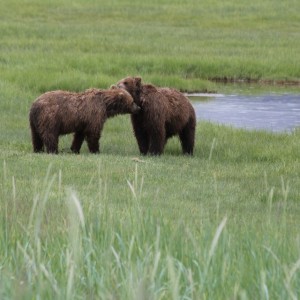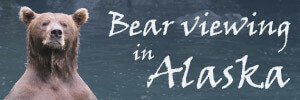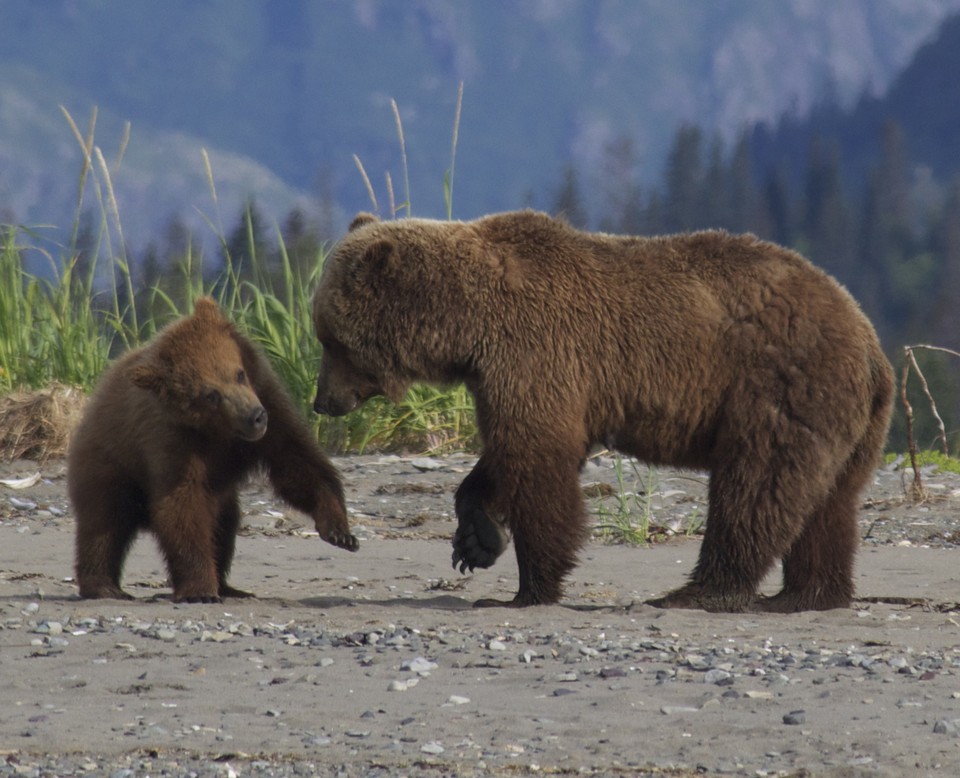Bear Viewing in Alaska
1-907-398-1744, Call Or Text
Get Acquainted with Alaska’s Grizzly Bears: Fact vs. Fiction

Welcome to the fascinating world of Alaska Grizzly Bears. At Bear Viewing in Alaska, we seek to not just observe these majestic creatures but to understand them, learn from them, and debunk popular myths surrounding them. Today, we delve deep into the world of grizzlies, separating fact from fiction.
The Majesty of Alaskan Grizzlies
Grizzly Bears in Alaska, are an awe-inspiring sight. Known for their distinct ‘grizzled’ or silver-tipped hair, these bears are a symbol of the wild Alaskan terrain.
They are among the largest and most powerful land predators. Capable of standing 8 feet tall on their hind legs and weighing between 500 and 900 pounds, their size is indeed impressive. But the grizzly’s uniqueness goes beyond just its physical stature.
Grizzlies possess an extraordinary sense of smell, surpassing even that of a hound dog. This heightened sense helps them locate food across vast distances. They’re also equipped with sharp, long claws, which aid in digging and hunting.
Their most remarkable feat, however, is hibernation. They can hibernate for up to 7 months, during which they don’t eat, drink, urinate, or defecate, slowing their metabolism to conserve energy.
Separating Fact from Fiction: Common Myths Debunked
When it comes to understanding Grizzlies, it’s vital to separate fact from fiction. Several myths and misconceptions surround these creatures. Let’s address some of the most common ones:
-
Fiction: Grizzlies are aggressive predators hunting humans
Fact: Contrary to popular belief, grizzlies avoid human contact. They are not natural predators to humans. Instead, they only attack when they feel threatened or provoked. If you keep a safe distance and avoid actions that might threaten them, your encounter should be conflict-free.
-
Fiction: Grizzlies can’t climb trees
Fact: This is a widespread misconception. Young grizzlies are adept climbers. While their increasing weight might limit this ability as they grow, they can climb trees when necessary, particularly when they sense danger.
-
Fiction: Grizzlies hibernate all winter
Fact: Grizzlies do hibernate, but the duration varies depending on their location and food availability. In regions with milder climates, grizzlies might hibernate for shorter periods or not at all.
Living with Grizzlies in Alaska
In Alaska, humans and grizzlies have learned to coexist. As civilizations expanded into grizzly territory, it became crucial to establish rules to ensure the safety of both bears and humans. In Alaska, a law prohibits feeding bears, deliberate or otherwise. Garbage must be disposed of securely to avoid attracting bears to human habitats, reducing the likelihood of dangerous encounters.
Learning to coexist with bears involves understanding their behavior and signs of stress. A bear that feels threatened may make bluff charges, stop to sniff the air, or swat the ground. If you encounter a grizzly in the wild, avoid direct eye contact, speak in a low, calm voice, and slowly back away without turning your back to the bear. Remember to carry bear spray, a non-lethal deterrent that can effectively ward off an advancing bear.
The Role of Grizzlies in Alaskan Ecosystem
Grizzlies play a vital role in Alaska’s ecosystem. As apex predators, they control other animal populations, promoting a balanced ecosystem. Additionally, grizzlies are a keystone species. When they catch salmon from the river, they carry their catch into the surrounding forests to eat in peace. The remains of the salmon, rich in nitrogen, act as a natural fertilizer, contributing to the lush Alaskan forests.
Further, grizzlies play an essential role in seed dispersal. The berries they consume pass through their system undigested, and the seeds, deposited in a different location through the bear’s droppings, contribute to the propagation of fruit-bearing plants.
Alaskan Grizzly Bear’s Status and Conservation
Grizzly bears, listed as a threatened species in the contiguous United States, are protected under the Endangered Species Act. However, in Alaska, where grizzly populations remain healthy, they’re managed as a sustainable game species.
Alaska Department of Fish and Game, National Park Service, and U.S. Fish and Wildlife Service work jointly to manage grizzly bears in Alaska. Together, they ensure regulations are enforced, including hunting limits and strict prohibitions on killing bears without justification.
Alaska Bear Tours: Your Chance to See Grizzlies in the Wild
Are you ready to marvel at the magnificent grizzlies in their natural habitat? Join us for our exciting Alaska Bear Tours. These tours are crafted to provide a safe, respectful, and awe-inspiring experience. For queries and bookings, contact us at 1-907-398-1744 or drop us an email at gamefish@alaska.net.
Our tours are more than just a wildlife viewing trip; they’re educational experiences. You’ll gain insight into the bears’ behavior and their role in the ecosystem. To learn more about bear viewing and other bear species in Alaska, take a look at our comprehensive guide “Your Ultimate Guide to Bear Viewing in Alaska: An Unforgettable Experience!” or our in-depth look at “Meet Alaska’s Bears: An In-Depth Look at Alaska’s Majestic Creatures“.
Bear Viewing in Alaska not only introduces you to these majestic creatures but also invites you to play a role in their conservation. Let’s ensure the legacy of the Alaskan Grizzly Bear continues for generations to come. Join us as we admire, learn, and safeguard these majestic creatures and their natural habitat.

